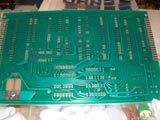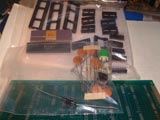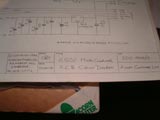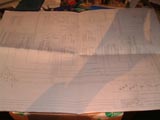|
Acorn System ONE an 8 bit dinosaur
Credits to binary dinosaurs at www.binarydinosaurs.co.uk
Yep, the first in a line of reasonably successful machines, the System 1 was
a single board computer (SBC) built round the 6502 processor. Originally available
as a kit, it came in 2 parts, both standard "Eurocard" sized, the
CPU module itself and a keyboard/display/cassette interface module that sat
on top of the CPU board. This kit I've got only has the CPU module, but I had
to have it since it's unbuilt :) Later machines in the range were simply numbered
2 to 5, steadily increasing in power and expandability. One interesting note
is that the System 2 had an external keyboard, and an optional case for said
keyboard became the case for the Atom.
Thumbnails:
All images and text © Adrian Graham 1999-2010 nless otherwise noted using words.
Some history
Clive Sinclair has a lot to answer for :) One of his long-term employees at Sinclair Radionics was one Chris Curry, who started Science of Cambridge for Clive and was a part of the small team who built the MK14 (one of the very first cheap home kit computers at £39.95) and the Sinclair wrist calculator. He wanted to expand the MK14 to have a BASIC interpreter and TV connection but Clive didn't since he was already pursuing the design of the Newbrain, so they parted company and Chris set up Acorn with a Cambridge University friend, Hermann Hauser.
The first machine they came up with was the System-1 in 1978, a 6502 based single board computer (SBC) that ran BASIC. It became the basis for their first 'real' machine, the Atom. Like most machines of the day aimed at the hobbyist market the Atom came as a kit to be soldered at home and later was available as an assembled system.
Next up came the concept of a machine called the Proton. It was to be a 16K machine with enhanced BASIC, colour, sound and expandability, but design issues meant it's development was stalled....also around this time the UK Government were pushing their Computer Literacy for Schools campaign and wanted a low-cost computer that could spearhead it; initially they were just going with the Newbrain from Newbury Labs, but production difficulties, a 2 year wait AND angry letters from Chris Curry and Clive Sinclair forced them to rethink. Initially they hadn't considered Sinclair and Acorn because they wanted a colour Z80 machine - the ZX81 was monochrome and the Atom was 6502 based.
The Proton was now nicknamed the Beebon and a rushed system was done in less than a week, and I have it on good authority that despite Fred Harris using a Beebon in the first series of 'The Computer Programme' the machine actually doing the work was a System 3 that sat under the desk :o)
Uncle Clive also got the Spectrum out the door faster than he should've done to go against the BBC, but the keyboard and lack of networking meant the Beebon still won and became the BBC Micro.
|







